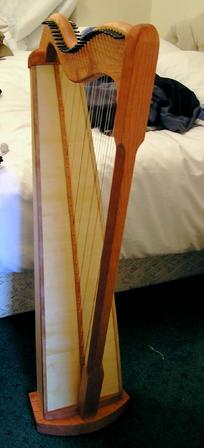

We arrived in Germany without many complications and made our way to the train station to work out how to get to the town for the harp course. We had been told that most Germans speak English, but we found that the people selling train tickets didn't seem to fall in that category. We managed to get information after a bit of a struggle, and booked a complicated but inexpensive route to Schwabisch Hall, the town for the course. It involved three trains and a bus. We figured we'd get to see the countryside this way, as well as saving money, and it would be easier to do this on the way down, when we weren't also towing harps.
The train trips did not prove very scenic, both because the train routes are in remote valleys without much to see and because the train windows were quite dirty. However, the bus trip was quite gorgeous, where we passed through what was clearly wine country, with lots of picturesque vineyards and a town with a castle/fort on top of a hill. We were met at the final train station by Eckhart, our contact and the local organizer of the course. Schwabisch Hall itself looked to be a gorgeous and historic town, and we regretted that the course was too far away for us to come back for some quick touring. Eckhart showed us a bit of it on our drive to the nature center where we stayed for the course.
The nature center is located in a forest, and was also very scenic. We met several of the other students and helped with room set-up while waiting for the other organizers to show up. We got our room (very cold room!) and settled in, and then headed down for the opening meal. The meals were all provided for the course, and most of them were traditional German meals, which were quite tasty and gave us a good idea of the local cuisine.
The course started that evening with our finishing the room set-up, picking the parts for our harps, and starting to design and carve the back sound holes for the sound boxes. Since neither Wayne nor I have any useful German, we were always a bit behind on what was going on, which meant we ended up with the "unchosen" harp parts. I like them just fine, so I don't think that hurt us any.
The teacher of the course, Andre, is a very colourful, interesting person. He would talk to the group in German and have them in stitches over various things he'd say, but we mostly didn't understand. He'd give them instructions for about 15 or 30 minutes for each step, as we'd watch as best we could and try to pick up on things from the demo. (This worked fairly well at times, but at others the Germans seemed to decide that since we got our own instruction we didn't need to see, and they would crowd us out so we couldn't really see what was being demonstrated.) After this long and involved instruction, he would come to us and give us maybe two minutes of recap. I'm not sure how much we missed, but undoubtedly a lot. Luckily, since I had built a harp from a kit before, I had a good idea about certain aspects of it, and knew enough about harps to guess at other bits.
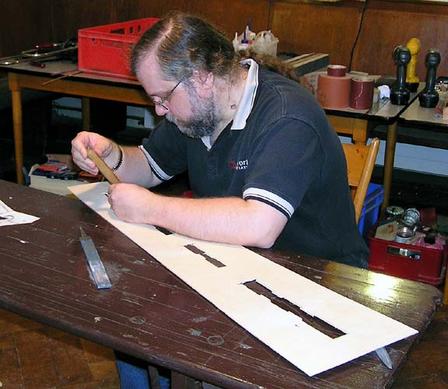
|
After asking a few questions about the soundhole requirements, we started
working on our designs. Wayne really wanted to do an outline of the Outer
Hebrides for the soundholes, which would have been lovely, but proved to be
impractical both for size/orientation considerations, and because it would
have been so complicated to carve that it would probably have taken way too
much time. Instead, he opted to carve the chanter and drones of a Highland
pipe. I invented a stylised bird design - sort of a Native American style
motif, to use as my soundholes. We worked until very late (later than most
of the students) trying to get the holes done that evening, but finally went
to bed unfinished.
|
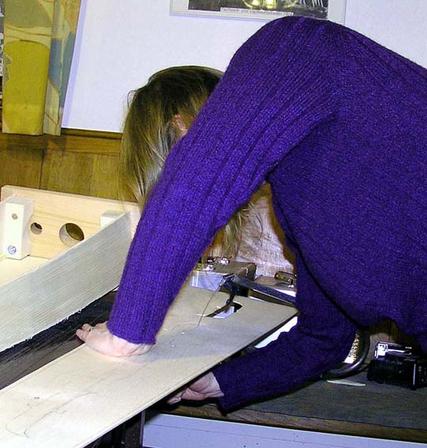
The next day, after breakfast, we immediately started working again, finishing up the carving and sanding of the backs of our harps. We also started carving/sanding on the harmonic curves and pillars for the harps. The, when partway into that, we digressed into building the sound box. We cut and sanded side strips for the box, then glued the back to the box and the side strips in place, attaching them using wooden pegs.
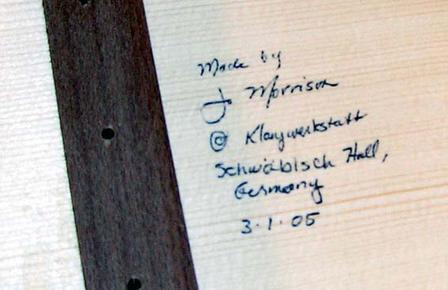
|
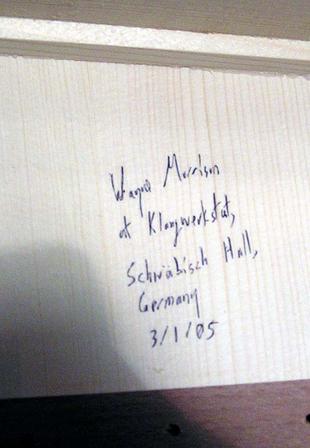
|
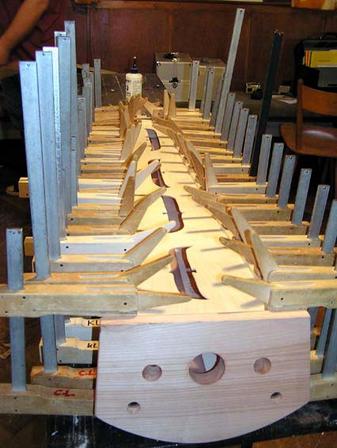
|
This second day I also met and talked to the instructor for the harp playing course that was going on simultaneously. Her name is Rheidun Schlesinger, and she is quite a talented harper, and extremely nice. She insisted on lending me her harp to play along with some things in the evening. We joined the ceili the first night very late, and only played a tune or two before retiring. My hands were so cramped and tired from sanding and carving that I couldn't play well anyway. We stayed around listening to others for a bit, hearing Andre do some of his funny German songs (meaning totally lost on us, but the others laughed the whole way through) and some great music from another harp/pipe duo (actually part of a larger group.)
The next day brought more work on the tops and pillars of the harp -- carving and shaping and sanding. When we got them shaped, we glued the pillar to the harmonic curve. We also finished any sanding and smoothing of the sound boxes and then gave both sections a coat of oil finish to protect them. After this had dried, we added bridge pins to the harmonic curve and grommets to the soundbox. By the end of this day Wayne and I had caught up with everyone else, and we were able to join in the ceili from the beginning. We had great fun - we learned/danced a couple of German dances, and I played early music with several other musicians, as well as joining in with Rheidun (on Andre's harp) and another harper on a few Celtic tunes. This was really great for me - it had been a hard week, not because anyone purposefully excluded us, but our lack of German made things difficult. Two or three of the students didn't speak much German, but most had good English. However, they held most of their conversations in German without thinking, and even conversations we started would quickly convert to German whenever the topic got more complicated (and interesting!) We knew we were missing all kinds of good stuff.
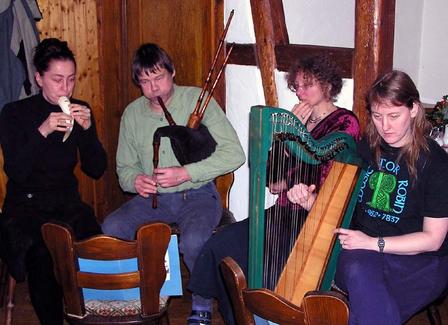
The final day of the course involved stringing the harps. The two parts of the harp we had built are only held together by the string tension. We inserted the tuning pegs, and got our sets of strings, and set to work tying knots (I learned a new way to tie knots, which I think will be easier to teach.) Once we had about half the strings through the soundbox, we put the two parts of the harp together and started pulling them together with the strings. Then we worked our way through the rest of the strings until it was all strung. After lunch (our final meal of the course) we each got Andre's help and instruction on tuning the harp up to pitch. He gave some good hints for helping extend string life and for quicker tuning for new strings.
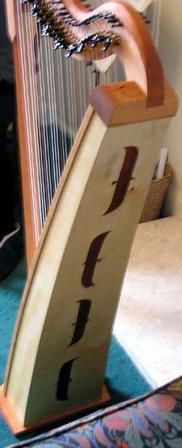
|
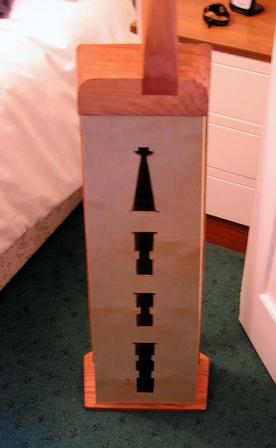
|